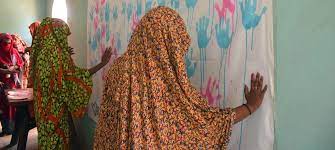Climate Change Impact on Women and Their Increased Vulnerability
Nancy M. Sidun, PsyD, ABPP, ATR
Nancy Sidun is a clinician psychologist, educator, administrator, researcher, and passionate advocate for human rights issues.
Header Photo Credit: from https://news.un.org/en/story/2019/07/1043391 – © UNHCR/Bahia Egeh, East Sudan. (24 July 2018)

A day does not go by without news of abhorrent weather conditions somewhere in the world. Climate-related disasters are intensifying and can significantly harm a person’s physical and psychological health. Due to the increase in greenhouse gases, the leading source of climate change (APA, 2022), the temperature worldwide is rising, causing variable and extreme weather. Since the late nineteenth century (IPCC, 2021), precipitation patterns have changed, leading to melting polar ice, rising sea levels, and increasingly severe storms, drought, flooding, heatwaves, and wildfires. Of the recorded natural disasters between 2008 and 2017, 84% were climate-related (UN News, 2021). During the first three months of 2023, within my country, the United States, there have been over 420 reports of tornadoes resulting in 70 deaths. Every month in 2023 has exceeded priors averages for tornadoes, with January’s total being the second highest on record (CDP, 2023).
In 2022, worldwide, there were multiple climate-related disasters. To highlight a few examples, Europe experienced its hottest summer: the heatwaves gravely increased wildfire risks. The Colorado River, which serves 40 million people in US western states and Mexico, drained at a startling rate, threatening the drinking water supply and power generation. Pakistan’s northern mountain region’s floods caused by record monsoon rain and melting glaciers killed more than 1,400 people, affecting millions more with food storage and lack of clean water. Already a drought-stricken country, blistering summer heat broke records and intensified food insecurity in China. The last example is the Hunga Tonga-Hunga Ha’apal volcano sent tsunami waves worldwide. It belched massive amounts of water vapor into the Earth’s stratosphere, likely contributing to more global warming (Ramirez, 2022). The detrimental impact of climate change has a global reach and varies across cultures, settings, and populations.
Given the worldwide experience of climate-related disasters, it would appear that the climate crisis impacts people equally, as extreme weather events occur globally and regardless of a country’s wealth, Gross Domestic Product, or development. However, climate change and increasing extreme weather events are more detrimental to the most vulnerable and disproportionately impact poorer countries (UN, 2021). These extreme weather and climate events lead to significant health problems (APA, 2022; Clayton et al., 2021). From 1970 to 2019, extreme climate events accounted for 45% of all reported deaths and 74% of all reported economic losses. More than 11,000 reported disasters attributed to these hazards globally, with just over two million deaths and $3.64 trillion in losses. Disproportionally deaths in developing countries accounted for 91% of the deaths related to extreme climate events (WMO, 2021). Rarely acknowledged are the mental health impacts of climate change (e.g., anxiety, depression, suicidality, and PTSD) (Clayton, 2021). Another consequence of natural disasters is climate refugees. In 2021, about 23.7 million people were forced to flee their homes due to natural disasters, with over half from East Asia and the Pacific (SDR, 2022).
The impact of climate change is disproportionate and influences lives and livelihoods differently. As stated earlier, specific populations are particularly vulnerable to climate change, including women, children, communities of color, Indigenous, the elderly, people with preexisting health issues, economically disadvantaged, homeless/displaced, and first responders (APA, 2022; Clayton et al., 2021). The 2021 United Nations Climate Change Conference of the Parties (COP26) affirmed climate change’s significant negative impact on women and girls, witnessing the significant human rights violations they experience (Stone et al., 2022; UN News, 2021). Furthermore, the intersectionality of these vulnerable populations is endless, causing intensified risks to climate change consequences (e.g., older women, BIPOC women, and displaced women).
To understand the intersection and relationship between climate change and gender, Dr. Judith Gibbons and I propose a conceptual model which explains why climate change has more detrimental consequences for women than men (Sidun & Gibbons, 2023). Women’s increased vulnerability is due to women’s precarity (unequal power) and corporal (physical) vulnerability. The adverse impacts of climate change on the lives of women and girls appear in multiple areas (i.e., education, food, and water security, economic stability, health and survival, reproduction, displacement, gender-based violence/exploitation, and human trafficking). In our proposed model, we not only acknowledge the “why” of women’s increased vulnerability to climate change but propose an avenue where women’s empowerment can directly combat climate change and break the links between it and its adverse impacts on women (Kwaku & Braga, 2017; UN News, 2021).
While climate-related disasters affect everyone, as noted above, it is not equal (Neumayer & Plümper, 2007; Jackson, 2019). To better understand this disparity of women’s increased vulnerability to negative consequences, feminist vulnerability theory highlights two factors contributing significantly to women’s heightened vulnerability. The first element is corporal; most women have less strength and are smaller in stature than men and exclusively experience pregnancy and childbirth. The second element, precarity, stems from unequal social power. This fuels women’s experiences of stereotyping, discrimination, structural barriers, and oppression (McLean, 2020).
There are many areas where climate change and climate-related events exacerbate existing inequalities for women and girls. Namely, their low economic status, preexisting disadvantages, developmental inequalities, and dependency on natural resources make them more vulnerable to climate change events (Park, 2019; Nguyen, 2019; Singhal, 2022). However, this blog will focus on one area where climate change dramatically impacts women: displacement and, ultimately, a marked increase in exploitation and human trafficking.
A remarkable finding by the United Nations reveals that 80% of displaced people are women (UN News, 2021). When displaced from one’s home, one becomes more vulnerable, and those that exploit are keenly aware of this and seize the opportunity to exploit the vulnerable. Adding to the vulnerability of being displaced, the prolonged recovery and reconstruction after climate-related events can also leave women and girls in crowded shelters and refugee camps, placing them at amplified risk for sexual assault and sexual exploitation/human trafficking (Cerna-Turoff et al., 2021; IFRC, 2015).
Contemporary slavery tends to escalate after natural disasters or conflicts where many people are displaced. Human trafficking is one of the gravest contemporary human rights violations. Human trafficking is a crime that occurs when a trafficker compels a person by force, fraud, or coercion to perform labor, services, and commercial sex. Those trafficked are stripped of the right to life and liberty, personal agency, freedom from slavery and torture, freedom of opinion and expression, the right to work and education, and physical and mental health — violating the fundamental human right to autonomy and freedom affirmed by the 1948 Universal Declaration of Human Rights (UN, n.d.). Current prevalence and accurate data of those trafficked are challenging to determine. Nonetheless, the International Labour Organization estimates that 20.9 million men, women, and children are victimized by forced labor, sex trafficking, and forced marriage worldwide. Women and girls account for 71% of all victims (ILO, 2018), with five women and two girls trafficked for every ten persons.
Climate-related events intensify vulnerabilities already present in communities and families. The trauma of the climate-related event could alone be enough to impact a disaster survivor’s life; however, desperation is common when displaced and unable to meet one’s immediate needs. After enduring a life-altering disaster, disruptions to local services, housing, economic stability, and social connections increase vulnerability and position women as prime targets for traffickers. Uprooted from their homes, separated from family and friends, disconnected from supportive services, and unable to safely earn income and be self-sufficient, women can become even more vulnerable and desperate. Compounding one’s vulnerability is when a woman does not speak the local language as they cannot communicate effectively.
Traffickers exploit desperation and gain control over the victim by exploiting their vulnerabilities. During environmental disasters, traffickers frequently control their victims through the need for essential resources such as shelter, food, and water. For example, people posing as aid workers following the 2015 Nepal earthquake reportedly trafficked many young women (Engage Together, 2018). Traffickers frequently impersonate trustworthy helpers who offer bogus assistance, such as misrepresented or non-existent job opportunities. Another example of increased trafficking occurred after Typhoon Haiyan in the Philippines. The Department of Social Welfare and Development in the Eastern Visayas noted that trafficking victims tripled. Nevertheless, they felt they could not capture the magnitude of the problem (Calma & Commentary, 2017). Five years after US’s natural disaster Hurricane Katrina in 2005, over 3,750 human trafficking survivors were identified; for comparison, 386 new survivors of human trafficking were identified by the National Human Trafficking Hotline in 2020 (York & Lane, 2022).
Climate-related events are intensifying, and thereby more women are at risk for adverse consequences, especially the severe human rights violation of human trafficking. Dr. Gibbons’ and my proposed conceptual model explain why women are more vulnerable to climate change; however, it also offers the promise of how women’s empowerment is essential to adapting to mitigating climate change, as well as advancing many of the Sustainable Development Goals of the United Nations (SDGs) (Sidun & Gibbons, 2023).
References
American Psychological Association (APA). (2022). Addressing the climate crisis: An action plan for psychologists. https://www.apa.org/science/about/publications/climate-crisis-action-plan.pdf
Calma, J. & Commentary (2017, May). Climate Change has created a new generation of sex-trafficking victims. Disaster’s Wake. https://qz.com/970394/climate-change-has-created-a-new-generation-of-sex-trafficking-victims
Center for Disaster Philanthropy (CDP) (2023). 2023 US Tornadoes https://disasterphilanthropy.org/disasters/2023-us-tornadoes/
Cerna-Turoff, I., Fischer, H-T., Mansourian, H., & Mayhew, S. (2021). The pathways between natural disasters and violence against children: A systematic review. BMC Public Health, 21(1). https://doi.org/10.1186/s12889-021-11252-3
Clayton, S., Manning, C., Speiser, M., & Hill, A. N. (2021). Mental health and out changing climate: Impacts, inequities, responses. American Psychological Association & ecoAmerica. https://ecoamerica.org/wp-content/uploads/2021/11/mental-health-climate-change-2021-ea-apa.pdf
Engage Together (2018). Natural disasters and human trafficking. Alliance for Freedom, Restoration, and Justice. https//engagetogether.com/2018/06/05/natural-disasters-and-human-trafficking/
International Labour Organization (ILO), (2018). Forced labour, modern slavery and human trafficking. http://www.ilo.org/global/topics/forced-labour/lang–en/index.htm
Intergovernmental Panel on Climate Change (IPCC). (2021). Climate change 2021: The physical science basis.Intergovernmental Panel on Climate Change. https://www.ipcc.ch/report/ar6/wg1/
International Federation of Red Cross and Red Crescent Societies (IFRC). (2015). Unseen, unheard: Gender-based violence in disasters. https://www.ifrc.org/Global/Documents/Secretariat/201511/1297700_GBV_in_Disasters_EN-LR2.pdf
Jackson, S. (2019). How are psychology and climate change related? Online Psychology Degrees. https://www.online-psychology-degrees.org/study/relationship-between-psychology-and-climate -change/
Kwauk, C., & Braga, A. (2017). Three platforms for girls’ education in climate strategies. Global Economy and Development at Brookings. https://www.brookings.edu/research/3-platforms-for-girls-education-in-climate-strategies/
McLean, L. (2020). Protesting vulnerability and vulnerability as protest: Gender, migration, and strategies of resistance. In S. Byrne, T. Matyók, I. M. Scott, & J. Senehi (Eds.). Routledge companion to peace and conflict studies (pp. 178-188). Routledge.
Nguyen, H. T., (2019). Gendered vulnerabilities in times of natural disasters: Male-to-female violence in the Philippines in the aftermath of super Typhoon Haiyan. Violence Against Women, 25(4), 421-40.
Neumayer, E., and Plümper, T. (2007). The Gendered Nature of Natural Disasters: The Impact of Catastrophic Events on the Gender Gap in Life Expectancy. Annals of the Association of American Geographers, 97(3), 551-566.
Park, A. (2019, Nov.). How climate change exacerbates gender inequality across the globe. TIME. https://time.com/5738322/climate-change-gender-inequality/
Ramirez, R. (2022). Devasting disasters and flickers of hope: These are the top climate and weather stories of 2022. CNN, https://www.cnn.com/2022/12/28/world/top-climate-weather-stories-2022/index.html
Sidun, N. M. & Gibbons, J. (2023). Women, girls, and climate change: Human rights, vulnerabilities, and
opportunities. [invited submission, currently under review] International Journal in Psychology
Special Issue on Human Rights.
Singhal, S. (2022). Climate change and women: A Crisis within a crisis. Observer Research Foundation. https://www.orfonline.org/expert-speak/climate-change-and-women
Statista Research Department (SDR) (2022). People displaced due to disasters worldwide from 2008 to 2021. https://www.statista.com/statistics/545876/number-of-people-displaced-due-to-disasters-worldwide/#:~:text=In%202021%2C%20about%2023.7%20million%20people%20around%20the,of%20disasters%20came%20from%20East%20Asia%20and%20Pacific
Stone, K., Blinn, N., & Spencer, R. (2002). Mental health impacts of climate change on women: A scoping review. Current Environment Health Reports 9, 228-243. https://doi.org/10/1007/s40572-022-00346-8
United Nations (n.d.). Universal Declaration of Human Rights. https://www.un.org/en/about-us/universal-declaration-of-human-rights
United Nations News. (2021). Climate and Environment. https://news.un.org/en/story/2021/11/1105322
World Meteorological Organization (WMO) (2021). WMO Atlas of mortality and economic losses from weather, climate and water extremes (1970–2019) https://library.wmo.int/index.php?lvl=notice_display&id=21930
York, H. & Lane, L. (2022). How natural disasters exacerbate human trafficking. Resilience https://www.domesticpreparedness.com/residience/how-natural-disasters-exacerbated-human-trafficking/

